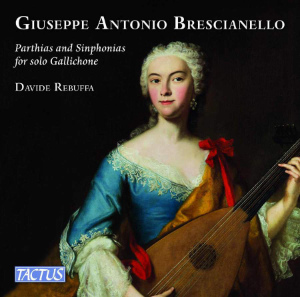
Giuseppe Antonio Brescianello (1690-1758)
Works for Solo Lute
Davide Rebuffa (gallichone)
rec. 2020, Basement Studio, Vicenza, Italy
TACTUS TC690203 [79]
Music for the solo lute in the Baroque period is more readily associated with composers north of the Alps rather than of Italy. The manuscript collection of 18 Partitas (as they are usually called) for gallicon which is drawn upon for this release, dating from around 1740, is now kept in Dresden’s Sächsische Landesbibliothek, and ascribes the music to Giuseppe Antonio Brescianello. The CD notes by the performer, Davide Rebuffa, cast some doubt on this, arguing that these works don’t bear much comparison with other instrumental compositions by that composer.
Brescianello was employed for most of his working life by the Duke of Württemberg, so the manuscript’s German provenance doesn’t discount his authorship. But whoever composed this pleasant and relatively undemanding music, it does perhaps exhibit an Italianate charm and clarity, rather than the harmonic or contrapuntal complexity more usually associated with the Germanic style of composition at the time, most notably in the solo lute music by Brescianello’s contemporary, Bach. Some of that was arranged from his works for solo violin, and so comparison with those works is also apt, as Brescianello’s Partitas otherwise have quite a lot in common in terms of structure and the types of movements they contain – both dances and abstract pieces.
In that regard Parthia XI bears the closest comparison perhaps, with its opening Allegro that features some imitation between the two lines of the music, and the concluding Allegro works a three-note semiquaver figure through various harmonic sequences that is rather like a toccata or prelude by Bach. The Adagio of the Sinphonia IX starts with a threefold rocking dotted figure over a repeated chord that comes to be developed a little and sounds like a very rudimentary echo of the opening movement of Bach’s C major Sonata for violin BWV1005. It is worth noting that, although this disc distinguishes between some of the works as a Parthia, and others as a Sinphonia, these terms do not derive from the manuscript and the CD notes omit to explain why they are so labelled.
Rebuffa’s interpretations are subtle and stately, neatly balancing the generally unchanging texture of a single melodic line in the upper register, with accompanying notes in a supporting lower register. Only rarely are three- or four-part chords employed by Brescianello, and when they are, Rebuffa’s playing remains fluent and unperturbed. But like Bach’s solo instrumental music, these scores still present the same engaging diversion for the mind’s ear to fill in the harmonies implied by what is written and played. Although the lower voice does sometimes hint at an alternative, subsidiary melodic line in the silences of the upper part, Rebuffa keeps in play a rhythmic interaction between the two parts which makes it clear that they are generally of equal importance, rather than one merely accompanying the other. Just occasionally, however, the lowest notes of the instrument’s register come out with a slightly unpitched twang in execution.
On the whole Rebuffa avoids any declamatory or rhetorical execution in these performances, which are faithful to the score by adding very few ornaments that aren’t in the manuscript, and keep within a modest range of dynamics yet are shaded effectively so that there is contrast. Often the effect is as though we are listening in on a private recital, as the performer contentedly courses through this engaging music. The recording was made in October 2020, reminding us that such consolatory, uplifting music for one player mist have been welcome in the uncertain and socially isolated times of the Covid pandemic. That simple pleasure in unaffected and intimate music-making is well conveyed on this recording, which deserves to be complemented by a companion volume featuring the other nine Partitas of the set.
Curtis Rogers
Help us financially by purchasing from



Contents
Praludio
Sinphonia I in C major
Parthia V in B flat major
Parthia VI in G major
Sinphonia VII in C major
Sinphonia IX in B flat major
Parthia XI in C minor
Parthia XII in C major
Parthia XV in G minor
Parthia XVI in D minor


















